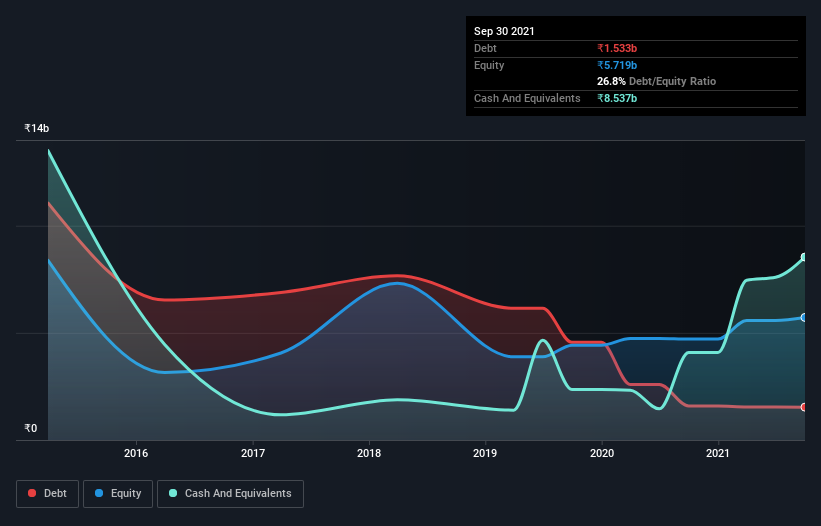- India
- /
- Trade Distributors
- /
- NSEI:MSTCLTD
These 4 Measures Indicate That MSTC (NSE:MSTCLTD) Is Using Debt Safely

Legendary fund manager Li Lu (who Charlie Munger backed) once said, 'The biggest investment risk is not the volatility of prices, but whether you will suffer a permanent loss of capital.' It's only natural to consider a company's balance sheet when you examine how risky it is, since debt is often involved when a business collapses. As with many other companies MSTC Limited (NSE:MSTCLTD) makes use of debt. But is this debt a concern to shareholders?
What Risk Does Debt Bring?
Debt is a tool to help businesses grow, but if a business is incapable of paying off its lenders, then it exists at their mercy. Part and parcel of capitalism is the process of 'creative destruction' where failed businesses are mercilessly liquidated by their bankers. However, a more frequent (but still costly) occurrence is where a company must issue shares at bargain-basement prices, permanently diluting shareholders, just to shore up its balance sheet. Of course, debt can be an important tool in businesses, particularly capital heavy businesses. The first thing to do when considering how much debt a business uses is to look at its cash and debt together.
Check out our latest analysis for MSTC
What Is MSTC's Debt?
As you can see below, MSTC had ₹1.53b of debt, at September 2021, which is about the same as the year before. You can click the chart for greater detail. However, it does have ₹8.54b in cash offsetting this, leading to net cash of ₹7.00b.

A Look At MSTC's Liabilities
Zooming in on the latest balance sheet data, we can see that MSTC had liabilities of ₹13.5b due within 12 months and liabilities of ₹1.21b due beyond that. Offsetting this, it had ₹8.54b in cash and ₹6.35b in receivables that were due within 12 months. So its total liabilities are just about perfectly matched by its shorter-term, liquid assets.
Having regard to MSTC's size, it seems that its liquid assets are well balanced with its total liabilities. So while it's hard to imagine that the ₹23.0b company is struggling for cash, we still think it's worth monitoring its balance sheet. Simply put, the fact that MSTC has more cash than debt is arguably a good indication that it can manage its debt safely.
In addition to that, we're happy to report that MSTC has boosted its EBIT by 43%, thus reducing the spectre of future debt repayments. When analysing debt levels, the balance sheet is the obvious place to start. But you can't view debt in total isolation; since MSTC will need earnings to service that debt. So when considering debt, it's definitely worth looking at the earnings trend. Click here for an interactive snapshot.
Finally, a company can only pay off debt with cold hard cash, not accounting profits. MSTC may have net cash on the balance sheet, but it is still interesting to look at how well the business converts its earnings before interest and tax (EBIT) to free cash flow, because that will influence both its need for, and its capacity to manage debt. Happily for any shareholders, MSTC actually produced more free cash flow than EBIT over the last three years. That sort of strong cash conversion gets us as excited as the crowd when the beat drops at a Daft Punk concert.
Summing up
While it is always sensible to investigate a company's debt, in this case MSTC has ₹7.00b in net cash and a decent-looking balance sheet. The cherry on top was that in converted 102% of that EBIT to free cash flow, bringing in ₹4.6b. So we don't think MSTC's use of debt is risky. There's no doubt that we learn most about debt from the balance sheet. But ultimately, every company can contain risks that exist outside of the balance sheet. For instance, we've identified 2 warning signs for MSTC that you should be aware of.
At the end of the day, it's often better to focus on companies that are free from net debt. You can access our special list of such companies (all with a track record of profit growth). It's free.
New: Manage All Your Stock Portfolios in One Place
We've created the ultimate portfolio companion for stock investors, and it's free.
• Connect an unlimited number of Portfolios and see your total in one currency
• Be alerted to new Warning Signs or Risks via email or mobile
• Track the Fair Value of your stocks
Have feedback on this article? Concerned about the content? Get in touch with us directly. Alternatively, email editorial-team (at) simplywallst.com.
This article by Simply Wall St is general in nature. We provide commentary based on historical data and analyst forecasts only using an unbiased methodology and our articles are not intended to be financial advice. It does not constitute a recommendation to buy or sell any stock, and does not take account of your objectives, or your financial situation. We aim to bring you long-term focused analysis driven by fundamental data. Note that our analysis may not factor in the latest price-sensitive company announcements or qualitative material. Simply Wall St has no position in any stocks mentioned.
About NSEI:MSTCLTD
MSTC
Engages in marketing, e-commerce, and scrap recovery and allied job businesses primarily in India.
Flawless balance sheet with acceptable track record.
Similar Companies
Market Insights
Community Narratives



